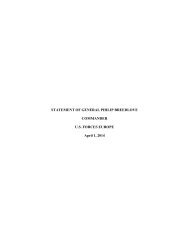FULLTEXT01
FULLTEXT01
FULLTEXT01
Create successful ePaper yourself
Turn your PDF publications into a flip-book with our unique Google optimized e-Paper software.
TACTICAL THOUGHT<br />
2014 September 29 th<br />
Result and conclusions<br />
The description is a pedominantly explanatory description. The potential of explaining<br />
content covers aspects such as strategy, operational art and tactics. Fighting power<br />
factors are covered e.g. physical and conceptual. The description explains<br />
characteristics from manipulation to threats of weapons of mass destructions (WMD),<br />
but focuses on the lower end of violence (subversion). Attitude aspects are included.<br />
Participating actors are described with a focus on the adversary. The description leans<br />
primarily on the political/civilian focus of the phenomena. The descriptions are<br />
comprehensive and have an explanatory articulation, but need pre-understanding or<br />
complementary sub-definitions of several terms. KilCullan’s descriptions might be seen<br />
as an argument for a new form of threats and enemies, focusing on the lower end of the<br />
“Hybrid Warfare School”.<br />
James Kiras<br />
James Kiras defines Irregular Warfare in 2008 as; “the use of violence by sub-state<br />
actors or groups within states for political purposes of achieving power, control and<br />
legitimacy, using unorthodox or unconventional approaches to warfare owing to a<br />
fundamental weakness in resources or capabilities”. 475 The definition addresses<br />
“violence” not specifying any level, thus, in theory, leaving open a field from civil<br />
disturbances to nuclear attacks. Only the sub-state actors or groups know or can use<br />
Irregular Warfare, according to the above definition; it is “their violence”. The character<br />
of violence is left to the reader, with no further explanation than, the approaches are<br />
“unorthodox” or “unconventional”. This form of explanation simply moves the<br />
definition problem from certain words to others; diffuse words such as “irregular” are<br />
changed to words e.g. “unorthodox” or “unconventional”. Kiras later defines five<br />
categories of Irregular Warfare as coup d’état, terrorism, revolution, insurgency and<br />
Civil War. 476 An earlier definition of Irregular Warfare by James Kiras from 2002 and<br />
2007, is outlined by the following working definition; “Irregular Warfare is the<br />
umbrella term used to describe violence used by sub state actors and including different<br />
forms, including terrorism and insurgency”. 477 Kiras defines terrorism as “the sustained<br />
use of violence against symbolic or civilian targets by small groups for political<br />
purposes, by inspiring fear, drawing widespread attention to a political grievance, and/or<br />
provoking a draconian or unsustainable response”.<br />
Thus terrorism does not by itself result in a political change, which is the sign and<br />
strategy of an Insurgency activity, according to Kiras. 478 Principal differences between<br />
Irregular and Conventional War are that the latter involves more or less symmetrical<br />
adversaries, in equipment, training and doctrine. In an Insurgency, the adversaries are<br />
asymmetric and weaker, almost always a sub-state group attempting to bring about<br />
political change by administrating and fighting more effectively than its state-based foe,<br />
475 Jordan, David, Kiras, James D., Lonesdale, David J., Speller, Ian, Tuck, Christopher and Walton, Dale<br />
C., Understanding Modern Warfare, (New York: Cambridge University Press, 2008), p. 232.<br />
476 Ibid. p. 232.<br />
477 Baylis, John, Cohen, Eliot, Gray, Colin S., Wirtz, James, Strategy in the Contemporary World (New<br />
York: Oxford University Press, 2007), pp. 164-167.<br />
478 Bylis at al, Strategy in the Contemporary World (2007), p. 165.<br />
60





